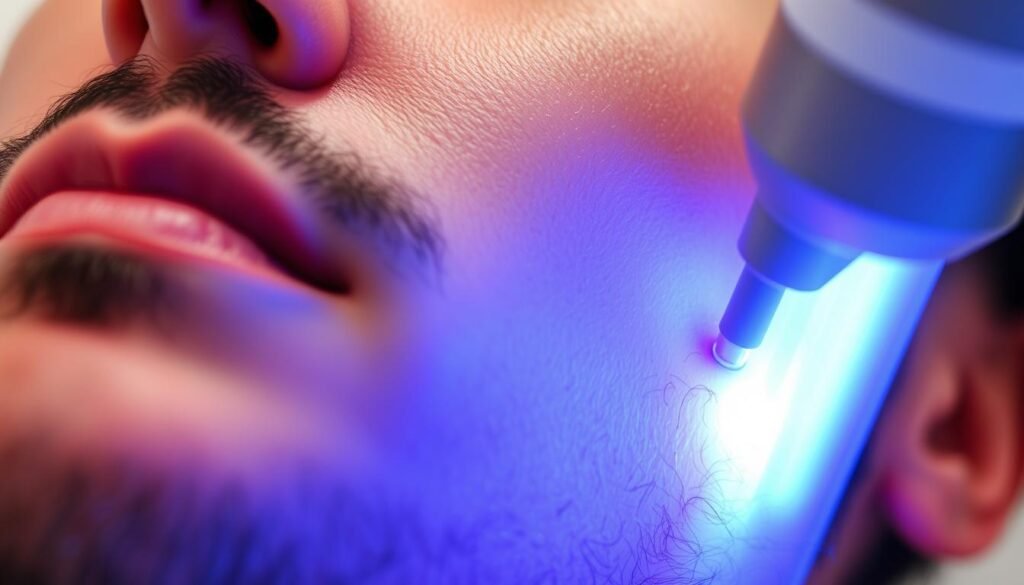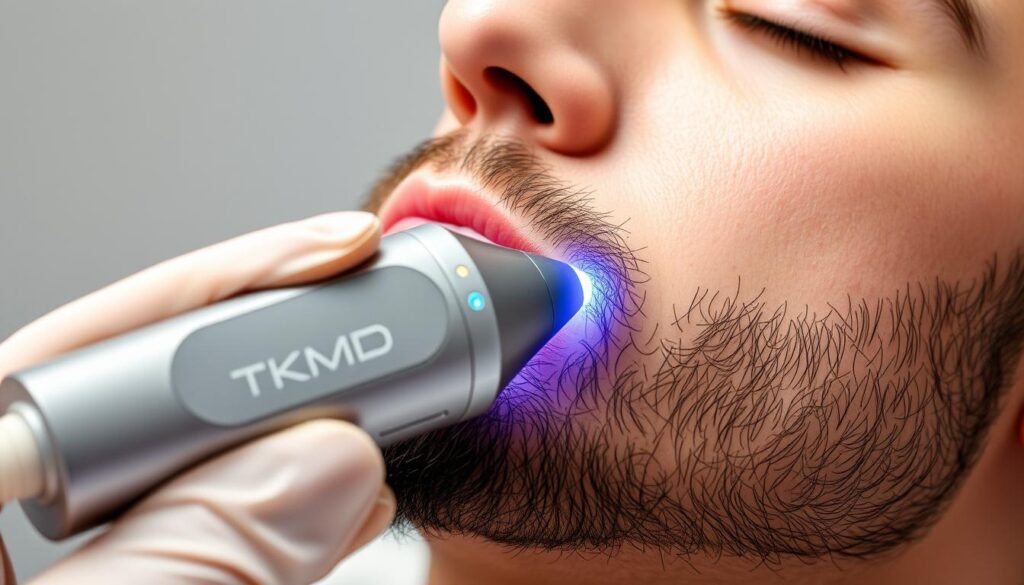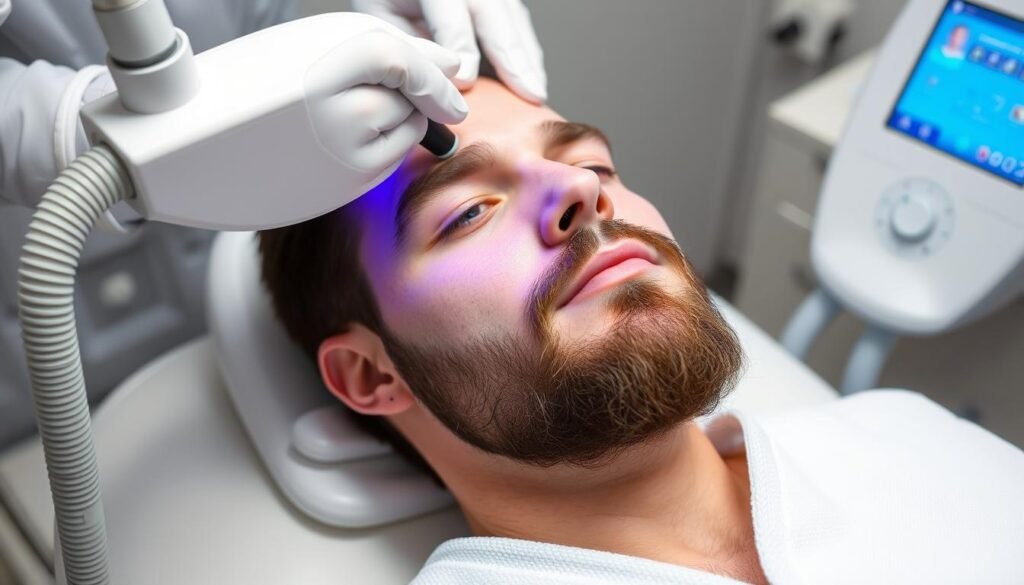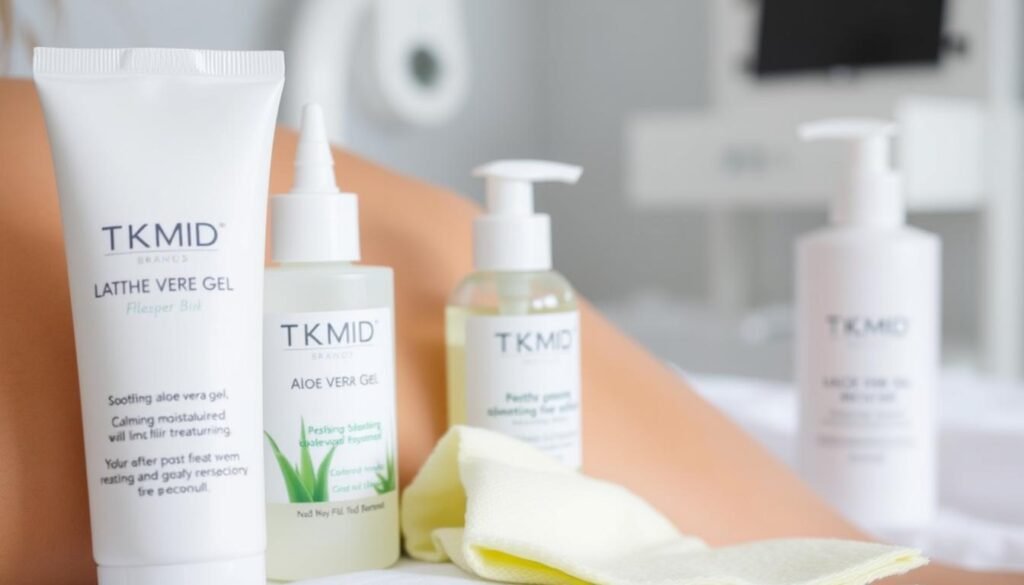For many, maintaining a well-groomed beard can be a daily challenge. Unwanted facial hair can be a nuisance, and traditional methods like shaving often lead to quick regrowth, resulting in a constant battle against stubble. Laser energy treatments offer a solution by targeting the root cause of unwanted hair growth.
Laser hair removal is a treatment that has gained popularity for its effectiveness in reducing unwanted hair. By understanding how it works and its benefits, individuals can make informed decisions about their grooming needs.
Key Takeaways
- Understand how laser hair removal works for beard management.
- Learn about the ideal candidates for laser hair removal treatments.
- Discover the customization options available for facial hair removal.
- Find out what to expect during and after the treatment process.
- Get insights into the permanence of laser hair removal results.
Understanding Laser Hair Removal for Beards
Laser hair removal for beards has become a popular solution for men seeking a more permanent way to manage facial hair. This treatment involves the use of laser technology to target and reduce hair growth, providing a smoother, more defined beard line or complete hair removal.
How Laser Technology Works on Facial Hair
Laser hair removal works by selectively targeting the hair follicle with a focused beam of light. The laser energy is absorbed by the melanin in the hair, converting to heat that damages the follicle and prevents future growth. As stated by a renowned dermatologist,
“Laser hair removal is a safe and effective method for reducing unwanted hair, especially for individuals with dark hair and light skin.”
The technology is particularly effective on facial hair because beard hairs typically contain high melanin concentration, making them responsive to laser targeting.
Who Is an Ideal Candidate for Beard Laser Treatment
Ideal candidates for beard laser treatment are typically those with darker hair and lighter skin, as this combination creates optimal contrast for the laser to target. However, advancements in laser technology have expanded its effectiveness for various skin tones. Men with hormonal conditions that cause excessive facial hair growth may also benefit from this treatment. It’s essential for candidates to have realistic expectations and understand that multiple sessions may be required to achieve desired results.
Before undergoing treatment, a consultation with a specialist is necessary to assess individual suitability based on skin type, hair color, and desired outcomes. This ensures that the treatment is tailored to each person’s specific needs.
Benefits of Laser Hair Removal for Beard
Laser hair removal offers numerous benefits for men looking to groom their beards. This treatment is not just about removing unwanted hair; it’s about enhancing one’s grooming routine and overall skin health.
Long-Lasting Results and Reduced Maintenance
One of the primary advantages of laser hair removal is its ability to provide long-lasting results, significantly reducing the need for daily shaving. Men can enjoy a well-groomed appearance without the constant upkeep.
Prevention of Ingrown Hairs and Skin Irritation
Laser hair removal effectively prevents ingrown hairs and skin irritation by targeting the hair follicle, reducing the occurrence of razor burn and bumps. This is particularly beneficial for men with curly or coarse facial hair.
Cost-Effectiveness Over Time
While the initial investment in laser hair removal treatments may seem substantial, the long-term cost-effectiveness becomes apparent when compared to the lifetime expenses of razors, shaving products, and time spent on daily grooming. A comparison of the costs can be seen in the table below.
| Method | Initial Cost | Long-Term Cost |
|---|---|---|
| Traditional Shaving | Low ($10-$20 for razors and creams) | High (Thousands of dollars over a lifetime) |
| Laser Hair Removal | High ($500-$1000 for initial treatments) | Low (Minimal maintenance costs post-treatment) |
“Laser hair removal has revolutionized the way men approach their grooming routines, offering a more permanent solution to unwanted hair.”
By considering these benefits, men can make an informed decision about whether laser hair removal is right for their beard grooming needs.
Customizing Your Laser Hair Removal Beard Treatment
Personalization is key when it comes to laser hair removal for beards, allowing for precise results. Laser hair removal for beards offers highly customizable treatment options tailored to individual grooming preferences and facial hair goals.
Full Beard Removal Options
For men seeking complete beard removal, treatment plans typically combine full-face and neck area sessions. This comprehensive approach achieves significant hair reduction across all facial hair zones.
Beard Line Definition and Shaping
Beard line definition treatments focus on creating precise lines along the cheeks, jawline, and neck. This results in a more defined and professional appearance while preserving the main beard area.
Neck Area Treatment
Neck area treatments are popular among bearded men who wish to eliminate the “neckbeard” while maintaining their facial hair. This reduces irritation in the sensitive neck area.
| Treatment Area | Benefits | Customization Options |
|---|---|---|
| Full Beard Removal | Comprehensive hair reduction | Combination of full-face and neck area sessions |
| Beard Line Definition | Precise, clean lines | Tailored to individual facial structure |
| Neck Area Treatment | Reduced irritation | Adjustable treatment intensity |

Preparing for Your Laser Beard Treatment
Proper preparation is key to maximizing the effectiveness of laser beard treatment. To ensure a smooth and successful treatment process, it’s essential to follow specific guidelines.
Pre-Treatment Guidelines
To optimize results, clients should shave the treatment area 24-48 hours before their appointment, ensuring hair is at stubble length. This allows the laser to target the follicle effectively. A consultation appointment before the first treatment is recommended to discuss medical history and create a customized treatment plan.
What to Avoid Before Your Appointment
Avoid alternative hair removal methods like plucking, waxing, or depilatory creams for at least 6 weeks before treatment. Limit sun exposure for two weeks prior and avoid tanning products. On the day of the appointment, refrain from applying aftershave, cologne, or scented products to the treatment area.
- Shave 24-48 hours before the appointment.
- Avoid plucking, waxing, or depilatory creams for 6 weeks.
- Limit sun exposure and avoid tanning products.
| Pre-Treatment Requirement | Guideline |
|---|---|
| Shaving | 24-48 hours before appointment |
| Avoiding Alternative Hair Removal | 6 weeks before treatment |
| Sun Exposure | Limit for 2 weeks prior |

By following these guidelines, you can ensure a safe and effective laser hair removal experience for your beard area.
The Laser Hair Removal Beard Process

The laser hair removal process for beards involves several steps that ensure effective and safe treatment. During a laser hair removal session for the beard area, the process typically begins with cleansing the skin to remove any oils or residues that might interfere with the laser’s effectiveness.
What Happens During a Treatment Session
The technician will provide protective eyewear for both themselves and the client. The handpiece glides over your beard line emitting gentle pulses. Before beginning the full treatment, many practitioners will perform a small test pulse on a discreet area to ensure the settings are appropriate for the client’s skin tone and hair type.
Pain Level and Comfort Measures
Most clients describe the sensation as similar to a warm rubber band snapping against the skin, with sensitivity varying based on individual pain tolerance and the specific area being treated. For clients with lower pain tolerance, topical numbing creams can be applied 30-45 minutes before the procedure to minimize discomfort. Throughout the process, the technician will check in about comfort levels and may apply cooling methods such as cold air or cooling gels to soothe the skin between laser pulses.
Aftercare and Recovery
To ensure optimal results from laser hair removal, it’s vital to adhere to a recommended aftercare regimen. Proper care following the treatment can significantly impact the effectiveness and comfort of the process.
Immediate Post-Treatment Care
Immediately after laser beard treatment, the skin may appear red and feel warm, similar to a mild sunburn. Applying aloe vera gel or a specialized post-laser soothing cream can help reduce discomfort. It’s essential to avoid sun exposure for at least two weeks and use a broad-spectrum SPF30+ sunscreen when going outdoors.
- Avoid hot showers, saunas, and strenuous exercise for 24-48 hours.
- Refrain from using scented products or harsh exfoliants.
Long-Term Maintenance Between Sessions
Between laser hair removal sessions, maintain gentle skincare practices. You can shave once the initial sensitivity subsides (usually after 10 days), but avoid other hair removal methods like waxing or plucking. Consistent treatment schedules, typically every 4-6 weeks, are crucial for achieving lasting results.
| Aftercare Aspect | Recommendation |
|---|---|
| Sun Protection | Use SPF30+ sunscreen when outdoors. |
| Skin Care | Apply aloe vera gel or soothing creams. |
| Hair Removal | Avoid waxing, plucking; shaving allowed after 10 days. |

Expected Results and Timeline
Understanding the timeline and results of laser hair removal for beards is crucial for setting realistic expectations. Laser hair removal works by targeting hairs in the active growth stage, leading to gradual hair reduction over several treatments.
Number of Sessions Required
The number of laser hair removal sessions needed for optimal results varies, typically ranging from 6 to 8 sessions. These sessions are usually spaced 4 to 6 weeks apart to align with the natural hair growth cycle.
Gradual Hair Reduction Process
Clients can expect a gradual reduction in hair growth, with noticeable thinning often observed after the second or third treatment. The reduction pattern is not linear, with more significant changes in the initial sessions followed by gradual adjustments in later treatments.
Permanence of Results
Most men achieve permanent beard line hair reduction, although some may require periodic maintenance sessions. The permanence of results depends on factors such as hormone levels, age, genetics, and the quality of the laser technology used.
| Treatment Factor | Description | Impact on Results |
|---|---|---|
| Hormonal Influence | Sensitivity to male sex hormones | May require more sessions or touch-ups |
| Hair Density and Color | Variations in hair characteristics | Affects the number of sessions needed |
| Laser Technology | Quality of the laser used | Influences the permanence of results |
By understanding these factors and the gradual process of laser hair removal, individuals can better anticipate their results and plan accordingly.
Addressing Common Concerns and Side Effects
With the growing demand for laser hair removal, addressing common concerns and side effects becomes vital for a well-informed decision. Normally, laser hair removal can leave the skin a little red or swollen immediately after the treatment, but this irritation subsides quickly.
Common side effects of laser beard treatments include temporary redness, swelling, and sensitivity that typically resolve within 24-48 hours after treatment. More serious but rare side effects can include blistering, hyperpigmentation, or hypopigmentation, especially in darker skin tones or when treatments are performed incorrectly.
It’s also important to consider the effectiveness of laser hair removal on different hair types. Coarse, dark hair responds best to treatment, while blonde, gray, or white hairs may not respond well due to insufficient melanin. Consulting with a qualified professional can help address these concerns and ensure the best possible outcome.
- Temporary side effects like redness and swelling are common but short-lived.
- Rare but serious side effects can occur, especially with improper treatment.
- Effectiveness varies based on hair type and color.


